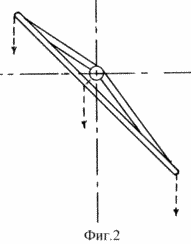| section Home
Production, Amateur Radio amateur Model aircraft, rocket- Useful, entertaining |
Stealth master
Electronics Physics Technologies invention |
space Mystery
Earth Mysteries Secrets of the Ocean Stealth section Map |
|
| Use of material is permitted for reference (for websites - hyperlinks) | |||
Navigation: => |
Home / Products Patents / In the section of the catalog / back / |
|
INVENTION
Russian Federation Patent RU2146775
![]()
Sail-bladed propeller for wind turbines
Name of the inventor: Alexander Kulakov
The name of the patentee: Alexander Kulakov
Address for correspondence: 141008, Moscow region, Mytischi, Mira, 4, kv.11, Kulakov AM.
Starting date of the patent: 1998.09.07
The invention relates to wind energy, namely wind turbines. The technical result consists in increasing the power sail-bladed propeller is achieved in that in the sail-paddle propeller comprising blades with axes staggered horizontally their rotations and stops for the blades mounted on the axles, according to the invention, the blades are located in a static state between the horizontal and vertical lines are shifted with respect to its rotation axis vertical, and the stops are installed behind the blades.
DESCRIPTION OF THE INVENTION
The invention relates to a wind turbine.
Known sailing-bladed propeller having blades with staggered horizontal axes on which they are pivotally planted and fixed stops on the axles / cm. The FR, No. 909873, Cl. F 03 D 3/00, 1946, page 5. FIG. 1/.
Object of the invention - increase power sail-blade propeller.
The task is achieved blades offset from its axis of rotation vertically, whereby the excessive weight of the blade, with the resulting displacement of the axis of the blade, opposed to the weight of the blade. This allows the aft wind wind along with the nose, take part in creating the difference in areas of the blades relative to the wind motion.
 |
 |
List of figures: Fig. 1 - sail-bladed propeller; FIG. 2 - blade.
DESCRIPTION OF THE INVENTION
Sail-bladed propeller / Fig. 1 / blade 1 comprises, offset both horizontally and vertically relative to the axis 2, to which they are pivotally suspended, resulting in a static state, the blades are arranged between the horizontal and vertical lines / Fig. 2 /. On 2 axles, rear blades 1, 3 stops installed.
OPERATION OF THE INVENTION
Originating wind will move the blade 1, located him aft, forward and up the radius relative to the axis 2, that is, will put it in a vertical position, and the blade 1, located to him the nose, the wind will move backwards and downwards with respect to its axis 2, placing it in a horizontal position. This work was stern and bow winds must end at the same time. Screw begins to rotate. When a strong wind vane 1, which has reached a vertical position, go on up to the departure back until is balanced by the wind, and the blade 1, has reached a horizontal position, abuts the fence 3.
Connecting to the wind aft of the nose of the wind give a large difference in areas with low wind, allowing the screw 1 / start with less wind; 2 / increase their power at all winds, not reaching design capacity; 3 / reach design capacity with less wind. The elimination of the stop in front of the wind sail allow spent on the twisting axis, used for its intended purpose. Proposed screw able to avoid overloads in high winds by further raising the sails up and, thus, reduce their wind resistance area.
Movement of the blade about its axis due to finding the most part on one side of the blade axis relative to its direction of movement of the wind. The movement of the blades relative to the common axis due to difference in the creation of areas of the blades relative to the wind direction of movement. Possibility of sailing-blade propeller to operate without stops due to the transfer of sails on the draft.
CLAIM
Sail-bladed propeller having blades with staggered horizontal axes of rotation, and stops for the blades mounted on axles, characterized in that the blades are located in a static state between the horizontal and vertical lines are offset relative to the axes of their rotation vertically and stops mounted rear blades.
print version
Publication date 31.01.2007gg




Comments
Commenting, keep in mind that the content and the tone of your messages can hurt the feelings of real people, show respect and tolerance to his interlocutors, even if you do not share their opinion, your behavior in terms of freedom of speech and anonymity offered by the Internet, is changing not only virtual, but real world. All comments are hidden from the index, spam control.